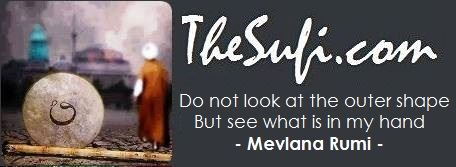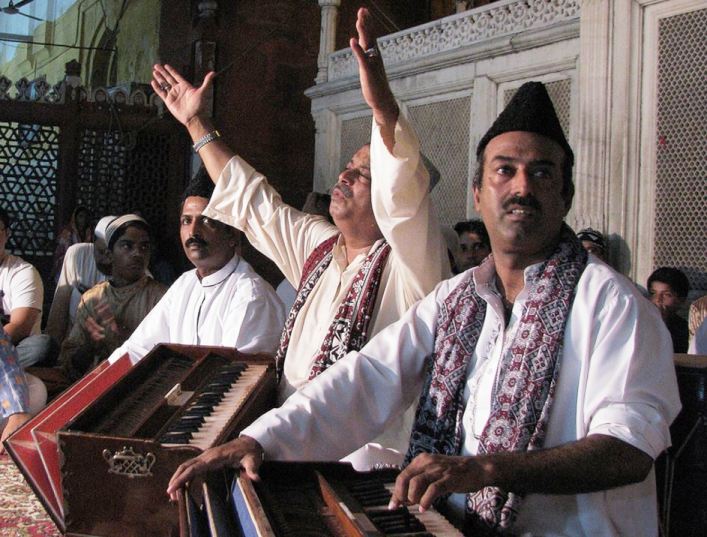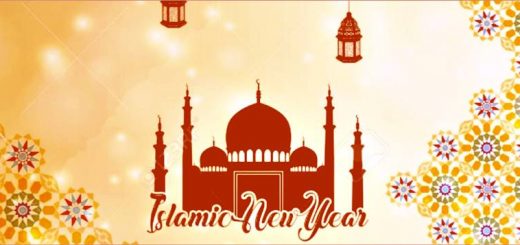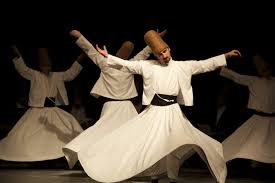8 Amazing Qawwalis of Ustad Farid Ayaz Qawwal & Abu Muhammad Qawwal
Ustad Farid Ayaz and Ustad Abu Muhammad Qawwal performing in Basti Hazrat Nizamuddin, Delhi
Dear Brother W,
Today the main custodians and representatives of the Qawwal Bachchon ka Gharana are Ustad Farid Ayaz and his brother Ustad Abu Muhammad. They are the sons of the renowned Ustad Munshi Raziuddin Ahmad Khan Qawwal (1912-2003). Ustad Munshi Raziuddin was not only a qawwal, he also was a formidable classical musician. He trained his sons in both traditions, and it must be said: Ustad Farid Ayaz and Ustad Abu Muhammad are outstanding qawwals, worthy successors to their father. Especially Ustad Farid Ayaz is an sublime and exceptionally gifted singer.
Ustad Ayaz and Ustad Abu Muhammad Qawwal regularly perform at the All Pakistan Music Conference (APMC), an annual music festival which is held in Lahore; both established Pakistani masters of music and young and upcoming talented singers and musicians take part in this festival.
I have recordings of a performance by Ustad Farid Ayaz and Ustad Abu Muhammad Qawwal at the APMC of 2007, which was published as a double CD. To make things easier I’ve numbered the songs of both discs from 1 to 8. Today I’m sending you these recordings. I add a few English translations for some of the qawwalis, as understanding what the lyrics of a qawwali mean enhances the joy of listening to them. Unfortunately I haven’t been able to provide translations for all the qawwalis. For some qawwalis I’ve also written some explanations that I thought might be useful.
Here are the qawwalis Ustad Farid Ayaz and Ustad Abu Muhammad Qawwal sang at the APMC of 2007:
1) Qaul: Man Kunto Maula. This is a qawwali of major importance. It is the “Qaul and Tarāna” of Hazrat Amir Khusrau (R.A.). “Qaul” (from the Arabic qawl – the term “qawwālī” is derived from this word) means “word”, “speech” or “saying”, more particularly an authoritative saying of a great and holy person. In this case the qaul is a transmitted saying of the Prophet Muhammad (S.A.W.S.) or a hadīth.
About three months before he left this world, the Prophet addressed a large crowd of his followers. This happened at an oasis between Medina and Mecca, where there is a pond named “Ghadīr Khumm” (the word ghadīr means “pond” in Arabic). There, Hazrat Muhammad took Hazrat Ali’s right hand and raised it, saying: “man kuntu mawlāhu, fa-hādhā ‘alīyun mawlāh”. In English this means: “If I have been your Mawla*, then Ali is your Mawla after me”, or: “If you have accepted me as your Mawla*, then Ali is your Mawla* too”. These are not literal translations (a literal tradition wouldn’t sound nice in English), but they convey the meaning of this hadīth correctly.
* Mawla is also often written as Maula, Moula, Mowla and Mola.
This hadīth is accepted as true and valid by both Sunni and Shia Muslims. To Sufis it is particularly significant, because it means that Hazrat Muhammad proclaimed Hazrat Ali his most important mystical heir and successor.
There is no single English word to translate “Maula” or “Mawla”. It is used as a title for God, for Hazrat Muhammad (S.A.W.S.) and the Prophet’s nephew and son-in-law, Hazrat Ali ibn Abi Talib (R.A. – d. 661).
“Mawla” or “Maula” can have several of meanings: “Lord”, “Master”, “Holy Friend of God”, “Protector”, “Benefactor”, “Spiritual Liberator” and “Saviour”.
Every Sufi Order has a “Silsila”, a chain of Masters who have succeeded each other. All Sufi Orders but one, trace their Silsila back to Hazrat Ali and thus to Hazrat Muhammad. An exception is the Naqhsbandi Sufi Order, whose Silsila is traced back to Hazrat Abu Bakr as-Siddīq (d. 634 CE – R.A.), who was one of the Prophet’s main Companions and the first Sunni caliph (successor to Hazrat Muhammad).
The hadīth which is the theme of this qaul has a version with a slight variation: “man kuntu mawlāhu, fa-‘alīyun mawlāh”. In this version the demonstrative pronoun hādhā (“this”) has been omitted, but this doesn’t change the meaning of the hadīth in any way. Ustad Farid Ayaz and Ustad Abu Muhammad Qawwal sing this particular version.
With great virtuosity and impressive skill they add a lot of extra poetry and vocal embellishments to highlight the core of this qawwali, i.e. the qaul. And of course they also sing the tarāna that completes this fundamental qaul:
“Dara Dil, Dara Dil, Dar Dani
Ham Tum Ta Na Na Na Na
Ta Na Na Na Re
Yalali, Yalali, Yala Re
Yalalala, Yalalala, Yalala Re”
As I’ve written before, the Tarāna genre was created by Hazrat Amir Khusrau (R.A.). Many contemporary classical vocalists believe that the syllables of a tarāna are abstract and meaningless. However, certain Sufi mystics have said that the syllables of a tarāna do have meaning; the famous Indian classical vocalist Ustad Amir Khan (1912-1974), who was very familiar with Sufism, said the same. See http://qaul.blogspot.be/2008/05/tarana-singing-ustad-amir-khan.html if you want to read more about it. Hindustani classical vocalists often sing a tarāna to conclude the presentation of a rāga.
Throughout the concert, Ustad Farid Ayaz and Ustad Abu Muhammad Qawwal make use of sargamimprovisation, i.e. improvising while singing the names of the notes of Hindustani classical music: Sa, Re, Ga, Ma, Pa, Dha and Ni. Sargam improvisation is widely practised by Hindustani classical vocalists.
2) Khabaram Rasid Imshab Keh Nigar Khwahi Amad. This is a Persian ghazal (a widely used poetic form, consisting of rhyming couplets), written by Hazrat Amir Khusrau. Singing ghazals is also practised as a light genre in Hindustani classical music.
Here’s an English translation of this ghazal:
“Tonight came the news that my beloved would arrive soon
May my head be sacrificed to the path on which you come riding!
All the gazelles of the desert have put their heads on their hands
In the hope that one day you will come to hunt them…
The attraction of love won’t leave you unmoved;
Should you not come to my funeral, you’ll definitely come to my grave.
My soul has come on my lips (e.g. I am on the point of dying);
Come, so that I may remain alive –
After I am no longer – for what purpose will you come?
By coming once you have stolen the heart, the religion and the patience of Khusrau;
[Imagine] what would happen if you came two or three times!”
Since this is Sufi music, “the Beloved” may be taken to be “the Divine Beloved”, or Hazrat Amir Khusrau’s Master, whom he love above all else: Hazrat* Khwaja Nizamuddin Auliya Chishti (d. 1325 CE).
* “Hazrat” (from the Arabic hadratun) is a title that expresses great reverence. It is often rendered as “His/Her Holiness”, but its literal and original meaning is “Presence”.
Ustad Farid Ayaz and Ustad Abu Muhammad Qawwal conclude this ghazal with a brief tarāna in classical style.
3) Sakhi Kase Ka Hoon. This is a song in a form of Hindi, and regrettably I can’t provide a translation.
4) Kasariya Balam – Ali Ji Mara. Again I’m unable to provide a translation.
5) Tarāna in Rāga Dēs. Here Ustad Farid Ayaz and Ustad Abu Muhammad Qawwal present a classical tarāna in Rāga Dēs, a rāga with a mood of longing.
6) Chhap Tilak Sab Chini Re Mose Naina(n) Milaike. I write the final –n of “nainan” between brackets because it is not fully pronounced, more or less like the final –n of the French word for “bread”, pain. This letter is typical for languages like Urdu, Hindi and Punjabi. Chhap Tilak Sab Chini Re Mose Naina(n) Milaike is a very famous qawwali. It is a song of love by Hazrat Amir Khusrau for his Beloved Master, Hazrat Khwaja Nizamuddin Auliya (R.A.).
Here’s an English translation of the lyrics:
“You’ve taken away my looks, my identity, by just a glance [literally: “When our eyes met”]
By making me drink the Wine of Love-potion,
You’ve intoxicated me by just a glance;
My fair, delicate wrists with green bangles in them,
Have been held tightly by you with just a glance
I give my life to you, Oh my cloth-dyer,
You’ve dyed me in yourself, by just a glance
I give my whole life to you Oh, Nijām,
You’ve made me your bride, by just a glance”
A peculiar aspect of many forms of Hindi is that “z” often changes into “j”. This is also the case here: “Nizām” becomes “Nijām”. Note that Hazrat Amir Khusrau (R.A.) has written this poem from the perspective of a young woman who is about to become a bride; in doing so, he emphasises the receptive aspect of the Sufi disciple or murīd.
When “dye” or “colour” is mentioned, a special quality of a Sufi Master or Saint is meant: “rang”. This word literally means “colour”, “dye” or “hue”, but there’s much more to it. “Rang” can only be described. I describe it as “the Glow of the Inner Essence of the Master”. I don’t know a better way to describe it.
7) Gar Nari Ga(n)wari Chahe So Kahe – Main Nijaam Se Naina(n) Laga Ayi Re.
This is another qawwali by Hazrat Amir Khusrau, an expression of his boundless love for his Master, Hazrat Khwaja Nizamuddin Auliya (R.A.):
The “n” in “Ga(n)wari” is again between brackets, for the same reason as “Naina(n)”.
Here’s a translation for “Gar Nari Ga(n)wari Chahe So Kahe”:
“Let the housewife say what she will,
I stole a glance from the eyes of Nijaam [= Nizamuddin Auliya]
His darling face and his charming form I have hidden in the depths of my heart.
Let Khusrau perish at the feet of Nijaam, I have just sold him a priceless maid [= Hazrat Amir Khusrau himself]
Khusrau! It is the blissful wedding night; I awake with my love
The body mine, the heart my lover’s -both coloured in the same hue”
This qawwal too is written from the perspective of a young woman who is about to become a bride. The marriage is a symbol for mystical union.
8) Haidariam, Qalandaram Mastam – Rang.
The final piece consists of two qawwalis. The first is a Persian poem by the Sufi Saint Hazrat Sharafuddin Bu Ali Shah Qalandar of Panipat (1209-1324 CE). His mausoleum or dargah is in Panipat, about 90 km north of New Delhi, is a place of pilgrimage.
Ustad Farid Ayaz introduces the song by reciting a few verses in Persian: “Say O Ali!, O heart, for this is the highest support! Sacrifice your life and soul at his feet – this the Way of Loyalty!”. This illustrates the importance the Sufis attach to Hazrat Maula Ali (R.A.). Hazrat Ali is regarded as the Perfect Sufi, the Perfect Master and the Spiritually Perfect Man. (Insān-e-Kāmil).
English translation of “Haidariam, Qalandaram Mastam”:
“I belong to Haidar, I am an intoxicated qalandar
I am the slave of Ali, the Chosen One [Murtaza = “Chosen by God because he is pleasing to God”]
I am the leader of all mystical drunkards [i.e. drunk with Divine Wine],
Since I am a dog in the Street of the Lion of God”
Tradition has it that Haidar, one of the names of Hazrat Ali, is derived from the Arabic word Hayy, meaning “Life” or “Living One”. Hayy is also one of the 99 Beautiful Names of God. However, in some Persian poetry it takes on the meaning of “dragon”. “Dar” is derived from the Persian verb darīdan, meaning “to tear up”, “to rip apart”. According to a traditional symbolical story, as a baby, Hazrat Ali tore a dragon to pieces from his cradle (the cradle is a symbol of innocence and purity; the dragon is a symbol for the lower, untrue ego – the nafs). Therefore “Haidar” might be translated as “Dragon Slayer”. Often Haidar is also rendered as “the Lion of God”, suggesting Hazrat Ali’s perfect and exceptional courage and strength. According to another version of this Persian traditional story, Hazrat Ali gripped the dragon’s mouth and held it tightly shut, to prevent later mystical seekers from walking into it.
Haidar is often combined with the word karrār. Haidar-e-Karrār means “The Lion of God or God’s Brave Warrior, who, when he is pushed back in battle, keeps coming back and continues to fight until the battle is won”. This refers to the inner battle against the nafs – a Sufi has to fight within himself over and over again.
Qalandars are wandering dervishes, who disregard social and religious conventions. Qalandars constantly strive for mystical intoxication (“mastī”). Some of them are highly accomplished mystics.
Finally, Ustad Farid Ayaz and Ustad Abu Muhammad Qawwal sing Hazrat Amir Khusrau’s “Rang”. For an interpretation of this word, see the notes for qawwali number 6. The “Rang” is said to have originated when Hazrat Amir Khusrau, after a very long and fruitless search, had found his true Master – Hazrat Nizamuddin Auliya (R.A.) – and told this to his mother, in a state of rapture.
Here’s an English translation of the “Rang” (“Aaj Rang Hai E, Maa(n), Rang Hai Ri”):
“What a Glow do I see now, O Mother, what a Glow!
See the Glow in my courtyard [i.e. “in his innermost being”, “in his heart”]!
I have found my Pīr, Nijamuddin Auliya! [“Pīr” is the Persian word for “Sufi Master”]
I roamed around the entire world, looking for an Ideal Beloved;
And finally this Face has enchanted my heart
The whole world has been opened for me,
Never seen a Glow like this before.
Whenever I see now, he is with me,
Oh Beloved, please dye me in yourself [i.e. “in your own Glow/Colour”]
Dye me in the Colour of Spring, Beloved!
What a Glow, O what a Glow!”
Hazrat Amir Khusrau’s “Rang” is usually sung at the end of a qawwali session.
Dear Brother, for now I have nothing more to add. I hope you’ll publish this brilliant music and my writings. In all humility I pray that they may benefit the many people who visit TheSufi.com.
Warmest regards,
Wazir








